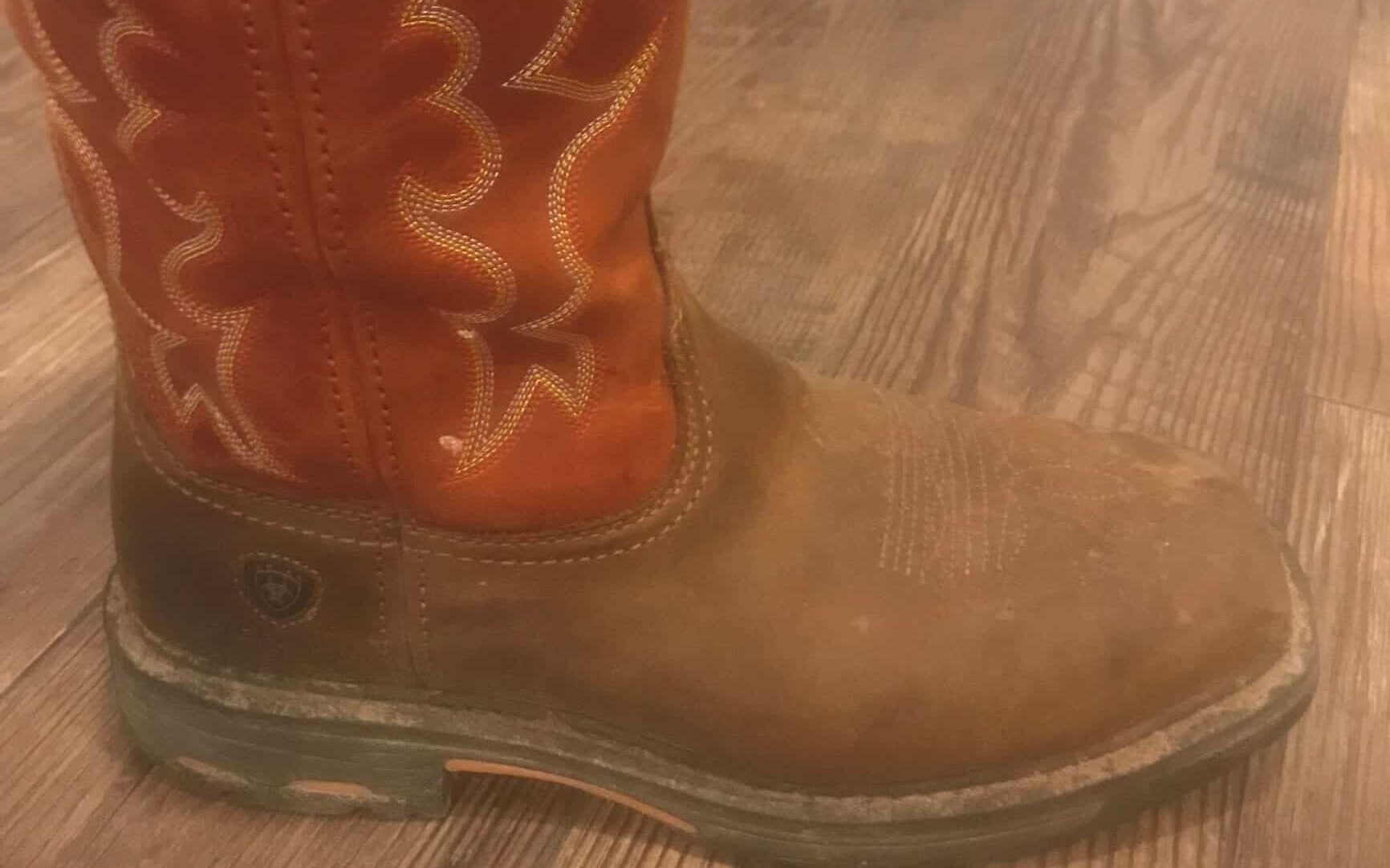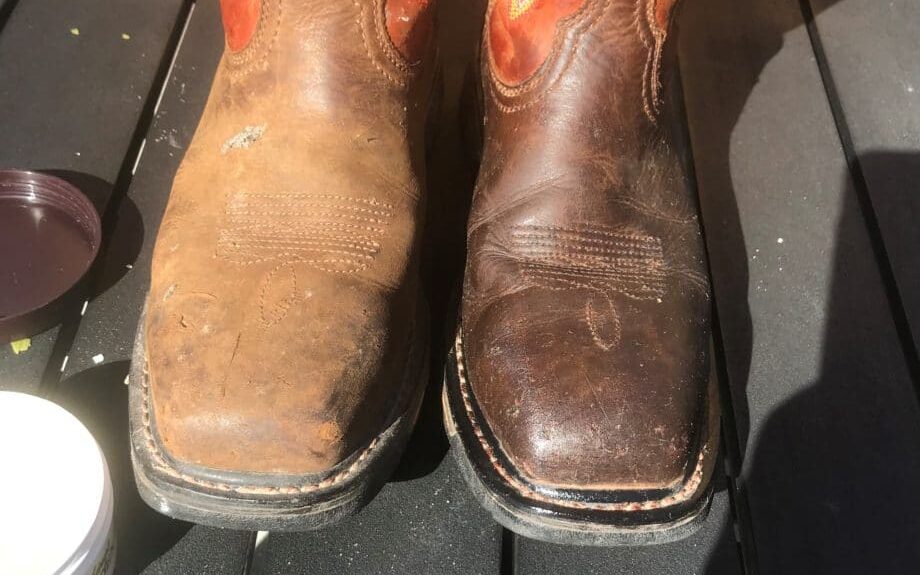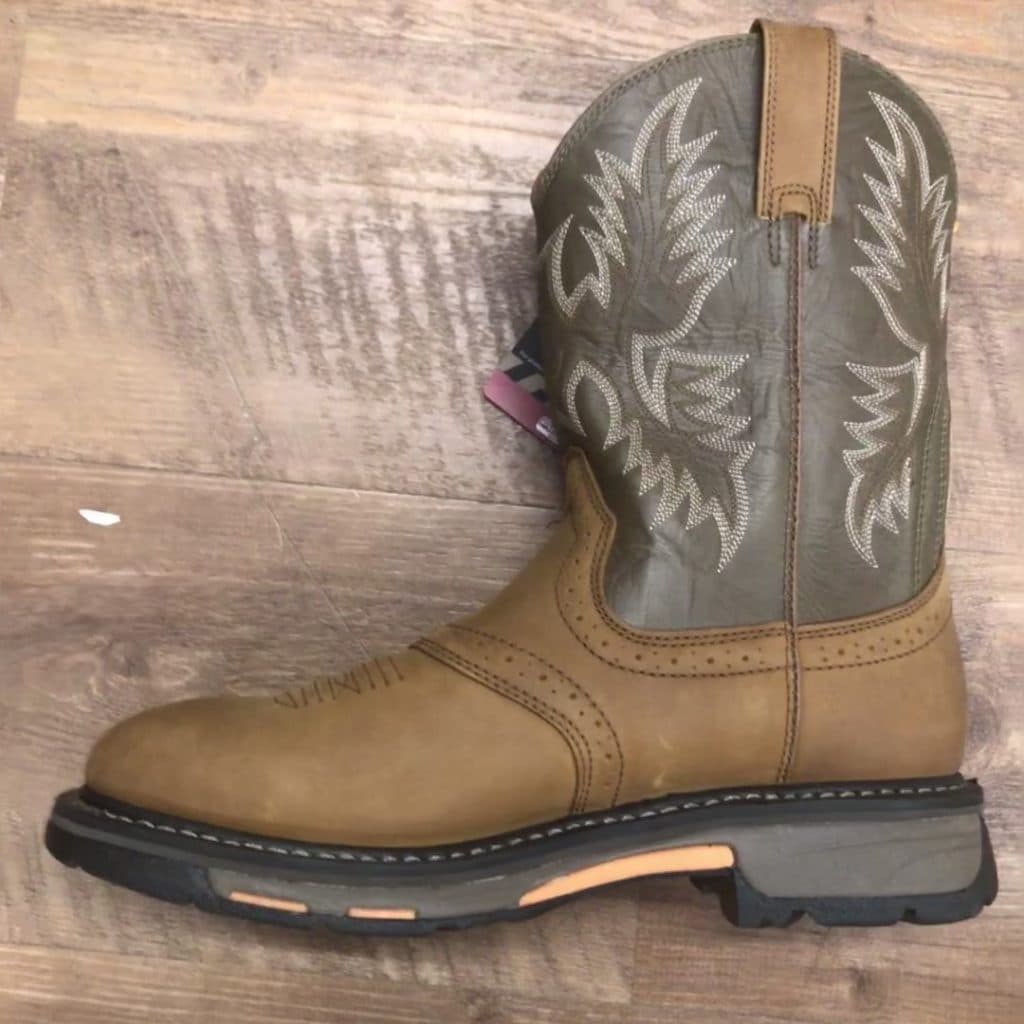Last updated: April 5, 2023
Any links on this page that lead to products on Amazon are affiliate links and I earn a commission if you make a purchase. Thanks in advance – I really appreciate it!
There’s no doubt about it; cowboy work boots are a staple on horse farms and at construction sites. And while there are many different types of cowboy work boots on the market, the two main contenders are steel toe and composite toe. So which one is right for you?
Steel toe boots are designed with a thick, strong piece of metal shielding the toes from potential impacts, whereas composite toe boots feature protection made of a composite material such as plastic or Kevlar. Steel toe boots are more affordable and provide excellent toe protection, while composite toe boots are lighter-weight, allowing increased mobility and breathability.
Knowing which type best suits you can be tricky, so we’ve created this comprehensive buyers’ guide to help make selecting the right product easier. This guide provides detailed information on both steel and composite toe designs, including their advantages, disadvantages, pricing points, and more.
Additionally, we’ll provide helpful tips on how to ensure that the boot fits properly and what features should be considered when purchasing cowboy work boots.
Ultimately, making an informed decision comes down to understanding your needs and budget – so it’s important to carefully evaluate all of the options before investing in a pair of work boots.
Different types of cowboy work boots
The cowboy boot has been an iconic part of American culture for hundreds of years, but it’s also become a popular choice for many industrial work environments.
Most modern cowboys don’t earn their living riding horses but work construction jobs requiring boots with safety toes. Since they love wearing cowboy boots, many bootmakers began designing cowboy boots made for industrial workplaces.
While steel or composite material toe caps are the go-to safety feature for most industrial boots, there are still options available for those who want to maintain their style while staying safe on the job.
Cowboy work boots with toe protection offer users both comfort and protection when working in hazardous conditions. From plain leather varieties to elaborately designed styles featuring Vibram soles, these boots combine modern engineering techniques with classic Western silhouettes.
The range of products available means that everyone can find something that meets their needs and preferences. With features like oil-resistant outsoles, water-repellent uppers, and reinforced stitching, these boots provide superior protection without compromising on style or comfort.
It’s time to take a look at some of the different types of cowboy boots made for work with toe protection available today.
Below is a YouTube video that provides insight into the differences between steel and composite toe boots.
Heavy Machines/Objects Protection
When working around heavy machinery, the best type of cowboy work boot is made with a durable steel toe and from durable, oil-resistant leather. The leather should be thick enough to protect feet from sharp objects but not so thick as to restrict movement.
Soles made with a good grip are also essential for safe footing when operating machinery. Steel or composite toe caps would offer additional protection for toes against impacts and crushing potentials.
A solid shank provides superior arch support and stability when climbing onto heavy equipment and uneven terrain. Cowboy boots with a waterproof membrane such as GORE-TEX will ensure feet stay dry during long shifts in wet conditions.
Lastly, it is important that the boots provide adequate ventilation to keep feet cool and prevent the accumulation of sweat inside the boots. With all these points in mind, workers can feel confident that they are wearing the best type of cowboy work boots when working around heavy machinery.
I like to wear these boots when working with young untrained horses. Their steel or composite toe protects the small, fragile bones from getting crushed if a horse happens to step on your foot.
Cold Weather Protection
Cowboy-style work boots are made for cold weather protection. The boots are made with a higher shaft that comes up to the calf, which helps keep the wearer’s legs warm. The boots also have a thick rubber sole that provides insulation and traction in cold weather conditions.
Many people bundle up in layers but tend to forget their feet. Insulated cowboy boots with composite materials like Kevlar or fiberglass are poor conductors of heat, making them better for cold weather wear than steel-toe boots.
Moisture Resistance
Cowboys often have to work in wet conditions. The last thing they want is water entering their boots. Workboots with moisture resistance or waterproof membrane can keep your toes and lower legs warm and dry. They can also protect you from splashing liquids in barns and stalls.
The downside to cowboy boots with a waterproof membrane is that it tends to trap heat. This can make wearing them uncomfortable in the warmer months as they can result in sweating.
Slip Resistance
Cowboy-style work boots are popular for those working in industrial settings where oil may be present. The slip-resistant qualities of these boots make them ideal for this type of environment, as they provide extra traction and stability.
Additionally, the rugged construction of cowboy-style work boots makes them durable and able to withstand tough conditions. They provide me with good traction around the barn when washing horses or working around the barn.
Puncture Resistance
Cowboy-style work boots are popular for their puncture resistance qualities. They are made with thicker soles and often a steel shank, which can prevent objects from going through the bottom of the boot.
This is important for working at industrial sites or horse barns where nails, screws, and other sharp objects are commonly encountered. Some cowboy work boots also come with special removable inserts that enhance puncture protection and also increase the wearer’s comfort.
Which is a better choice, steel or composite toe work boots?
When it comes to choosing the right workboot for the job, there are many factors to consider. One important decision is between steel toe and composite toe cowboy workboots. Both types have their own advantages and disadvantages, and the best choice will ultimately depend on your needs.
Steel toe boots are typically more durable and provide better protection against impact and compression injuries. However, they can be heavy and uncomfortable and may not be suitable for workers who need to be on their feet all day.
Composite toe boots, on the other hand, are usually lighter and more comfortable. They also don’t conduct heat or cold as well, making them a better choice for workers in extreme conditions. However, composite toes can be more expensive than steel toes and may not provide as much protection in certain situations.
Pros of Steel Toe Workboots
- Superior protection from heavy objects – Steel toe boots can withstand almost 75 lb. of falling pressure of an object thrown from three yards. Some steel-toe cowboy boots can handle 3.5 tons of weight!
- OSHA compliance – Many workplaces require workers to wear steel-toe boots. Employers can even send the worker home if they aren’t wearing them.
- They protect against burns, cuts, splashes of hot liquids, chemical burns, electrical hazards, lacerations, and puncture wounds.
- Steel-toe boots last longer than composite-toe boots because they are resistant to damage.
Cons of Steel Toe Workboots
- Steel-toe boots tend to be heavy.
- They could get uncomfortable for workers, especially those who have to stand for prolonged periods of time.
- They also tend to be uncomfortable in very hot environments.
- Passing through metal detectors at airports in your steel-toe cowboy workboots can be a hassle.
Pros of Composite Toe Cowboy Work Boots
- Composite toe workboots offer superior resistance to electricity. They are also OSHA and ASTM-compliant.
- They are lighter than steel-toe boots, enhancing their comfort, especially for people who have to stand for prolonged periods.
- Composite toe boots are a better choice in extreme heat or cold environments as they do not conduct heat.
- You can easily pass through metal detectors wearing your composite-toe cowboy work boots that are made from Kevlar, plastic, or fiberglass.
Cons of Composite Toe Cowboy Work Boots
- They are not as strong as steel-toe cowboy boots. Composite boots need to be a lot thicker to handle the same load/weight as their steel-toe counterparts.
- Some composite-toe cowboy boots tend to be more expensive than steel-toe boots.
- Metal composite toe boots could also set off metal detectors.
- They may not be allowed in all workplaces, especially if there are electrical hazards around.
Which is the Better Choice?
As can be seen, both types of cowboy boots come with their sets of benefits and disadvantages. Composite toe boots are lighter and provide more protection against electrical shocks; they also are better for wearing in extremely cold weather.
Steel toe is a better choice if protection for your feet from crushing injuries is your primary concern or if you need OSHA-compliant boots. In any case, it is essential to select a boot that is comfortable.
Ensure that the cowboy boot you select, whether steel toe or composite, has a snug fit – not too loose or tight. This is important to prevent bunions and pain in the toe box area and to prevent your feet from moving inside roomier boots.

How to choose the right pair of cowboy boots for your needs?
Have you ever had a horse step on your feet? I think this happens to anyone who works with horses. This is my main need when I choose a pair of cowboy boots to work in; however, most of my friends are required to wear protective boots on job sites. So, here are some tips to help you select the right pair of cowboy boots:
Comfort, Size, and Fit
Take your time selecting the boots. Try on several pairs. Ensure that the boots have a perfect fit – not too tight or too loose. Too big boots will cause your feet to move in the boots. Too narrow, and your feet will feel crowded, leaving you with blisters and hot spots.
Wear the same socks that you wear in the saddle. (Ideally, you must select moisture-absorbing socks to keep your feet sweat-free. In winter, select thicker pair of socks to keep the toes warm).
Walk around in the boots and ensure that you feel comfortable, can walk easily, and do not experience any pinching, chafing, etc.
Weight of the Boots
Ensure that the boots are not too heavy. The weight of the boot will depend on the materials used. Some composite cowboy boots consist of leather and textile uppers which help reduce the weight. Steel-toe work boots are usually heavier than composite-toe boots. The ones that have steel in the shank tend to be even heavier.
Heel Height
Many Western-style workboots have a higher heel of around 2 inches. However, some steel-toe roper boots have shorter heels, and some have flat soles. Try these different styles to see which heel height suits you.
In general, shorter heel boots are more comfortable for walking and doing barn chores, while higher heel boots may be better for riding.

Tips on how to care for your new cowboy workboots.
A new pair of cowboy boots is a significant investment. Not only do they need to be comfortable, but they also need to be durable enough to stand up to long hours spent working on your feet. Here are a few tips to help you get the most out of your new cowboy workboots.
Break Into Them Gradually
Once you bring home your boots, break into them gradually by wearing them for several hours at a time (no more than 2 hours per day). Some people even use special boot conditioners to break into their boots. Remember: new cowboy work boots can easily take over 40 hours to break in.
Clean Them Regularly
Depending on the material of the upper, you will need to use different techniques for cleaning your workboots. Some materials like leather and textile boots are best cleaned with a brush and a damp cloth.
I typically wipe my boots to get the dirt off and then apply mink oil. You can see the results in the above picture. To clean the insides of the boots, you can use a gentle shampoo (low-pH shampoo). Brush the seams with the brush to remove dirt and grime.
Apply Waterproofing Layer
You can now apply some waterproofing wax to the boots’ uppers. After the first layer dries, apply the second one and a third coat to ensure maximum water repellency. Use a leather conditioner to prevent the boots from drying and cracking.
Dry Wet Boots before Storing
If your boots get wet in the rain, stuff old newspapers or cedar boot trees to prevent them from shrinking.
When you take care of your workboots, your workboots will take care of you!
Wrap-Up
When it comes to cowboy work boots, there are two main types: steel toe and composite toe. Both have their own unique benefits and drawbacks, so it can be difficult to decide which type of boot is right for you.
Steel-toe cowboy work boots are more durable and provide better protection against workplace accidents. However, they can be quite heavy and are not always as comfortable as composite-toe boots. Composite-toe boots are typically lighter and more comfortable but may not be as strong as steel-toe boots.
In the end, the decision of which type of cowboy work boot to buy comes down to personal preference. It is important to consider the specific needs of the job you will be using the boots for and your individual preferences.
I hope this article helped you understand the difference between these two types of boots and made it easier for you to choose the right pair for your needs.
FAQs – Steel Toe vs. Composite Toe Cowboy Work Boots
Who makes the most comfortable composite toe work boot?
There is no one-size-fits-all answer to this question, as the most comfortable work boot for someone might not be the most comfortable work boot for someone else.
That said, some brands that are often cited as making very comfortable composite-toe work boots are Wolverine, Ariat, and Justin.
What are the best, most comfortable steel-toe work boots?
There are a lot of different work boots on the market, and it can be tough to find the perfect pair that is both comfortable and safe. Some of the best brands of steel-toe work boots include Timberland, Cat, and Carhartt.
Do composite toe work boots get cold?
Composite-toe work boots don’t get as cold as steel-toe boots, but your toes may still feel cold if the external temperature is below a certain point. Make sure to purchase a good quality pair of work boots that will provide adequate insulation for your job type and climate.
Are composite toe boots OSHA-approved?
Composite toe boots may be acceptable for use in certain situations where there is a risk of foot injury from falling or rolling objects. In order to be considered compliant with OSHA’s standards, composite toe boots must meet certain requirements for impact resistance and compression resistance.

About the Author: Miles Henry
Lifelong Horseman | Racehorse Owner | Published Author
Miles Henry brings over 25 years of hands-on experience training and owning Thoroughbred racehorses. Raised with Quarter Horses and Appaloosas, he’s spent a lifetime learning from horses—on the track, in the barn, and in the field. Today, he runs a small but successful racing stable in Louisiana and shares real-world insights on HorseRacingSense.com, helping horse owners, fans, and bettors navigate the sport with confidence.
📚 Books: View Miles’s books on Amazon »
🎧 Podcast Guest: Animal Tales Ep. 32 |
YouTube Interview
📩 Newsletter: Sign up for racing tips and horse care advice »
🔗 Follow Miles:
Twitter |
Facebook |
YouTube




